70 Graph Quadratic Functions Using Properties
Learning Objectives
By the end of this section, you will be able to:
- Recognize the graph of a quadratic function
- Find the axis of symmetry and vertex of a parabola
- Find the intercepts of a parabola
- Graph quadratic functions using properties
- Solve maximum and minimum applications
Before you get started, take this readiness quiz.
Recognize the Graph of a Quadratic Function
Previously we very briefly looked at the function ![]() , which we called the square function. It was one of the first non-linear functions we looked at. Now we will graph functions of the form
, which we called the square function. It was one of the first non-linear functions we looked at. Now we will graph functions of the form ![]() if
if ![]() We call this kind of function a quadratic function.
We call this kind of function a quadratic function.
A quadratic function, where a, b, and c are real numbers and ![]() is a function of the form
is a function of the form
We graphed the quadratic function ![]() by plotting points.
by plotting points.
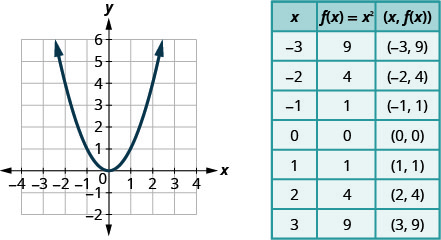
Every quadratic function has a graph that looks like this. We call this figure a parabola.
Let’s practice graphing a parabola by plotting a few points.
Graph ![]()
We will graph the function by plotting points.
| Choose integer values for x,
substitute them into the equation and simplify to find Record the values of the ordered pairs in the chart. |
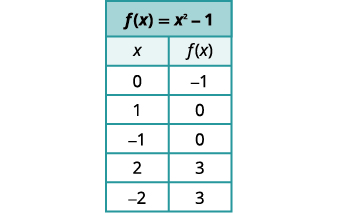 |
| Plot the points, and then connect
them with a smooth curve. The result will be the graph of the function |
 |
Graph ![]() .
.
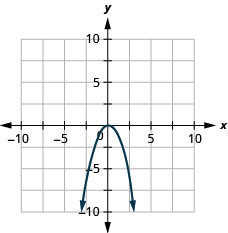
Graph ![]()
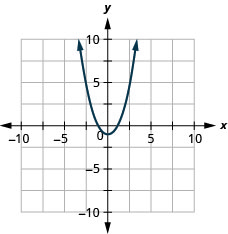
All graphs of quadratic functions of the form f (x) = ax2 + bx + c are parabolas that open upward or downward. See (Figure).
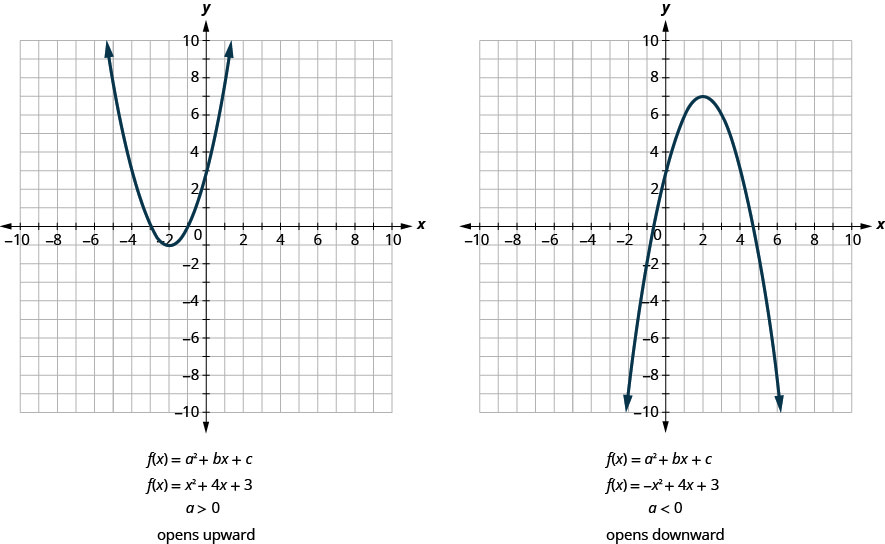
Notice that the only difference in the two functions is the negative sign before the quadratic term (x2 in the equation of the graph in (Figure)). When the quadratic term, is positive, the parabola opens upward, and when the quadratic term is negative, the parabola opens downward.
For the graph of the quadratic function f (x) = ax2 + bx + c, if

Determine whether each parabola opens upward or downward:
ⓐ![]() ⓑ
ⓑ![]()
ⓐ
| Find the value of “a”. |  |
| Since the “a” is negative, the parabola will open downward. |
ⓑ
| Find the value of “a”. |  |
| Since the “a” is positive, the parabola will open upward. |
Determine whether the graph of each function is a parabola that opens upward or downward:
ⓐ![]() ⓑ
ⓑ![]()
ⓐ up; ⓑ down
Determine whether the graph of each function is a parabola that opens upward or downward:
ⓐ![]() ⓑ
ⓑ![]()
ⓐ down; ⓑ up
Find the Axis of Symmetry and Vertex of a Parabola
Look again at (Figure). Do you see that we could fold each parabola in half and then one side would lie on top of the other? The ‘fold line’ is a line of symmetry. We call it the axis of symmetry of the parabola.
We show the same two graphs again with the axis of symmetry. See (Figure).
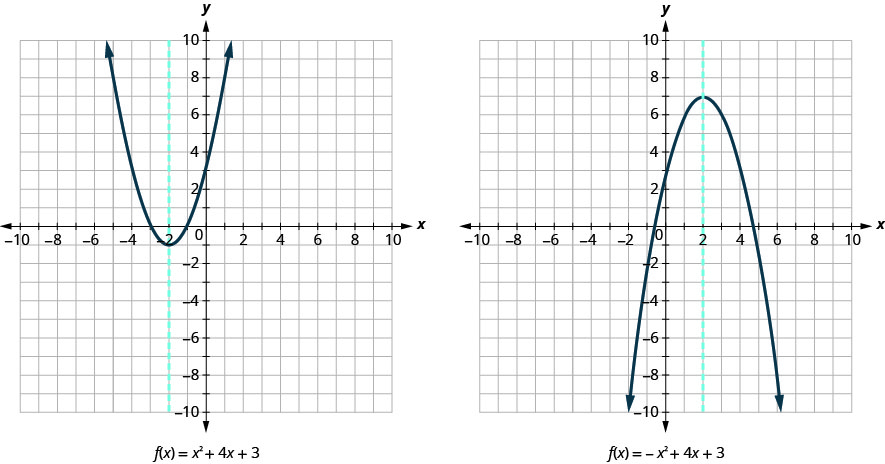
The equation of the axis of symmetry can be derived by using the Quadratic Formula. We will omit the derivation here and proceed directly to using the result. The equation of the axis of symmetry of the graph of f (x) = ax2 + bx + c is ![]()
So to find the equation of symmetry of each of the parabolas we graphed above, we will substitute into the formula ![]()
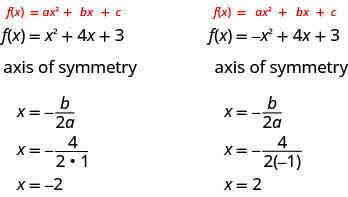
Notice that these are the equations of the dashed blue lines on the graphs.
The point on the parabola that is the lowest (parabola opens up), or the highest (parabola opens down), lies on the axis of symmetry. This point is called the vertex of the parabola.
We can easily find the coordinates of the vertex, because we know it is on the axis of symmetry. This means its
x-coordinate is ![]() To find the y-coordinate of the vertex we substitute the value of the x-coordinate into the quadratic function.
To find the y-coordinate of the vertex we substitute the value of the x-coordinate into the quadratic function.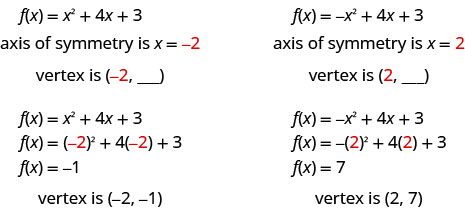
The graph of the function f (x) = ax2 + bx + c is a parabola where:
- the axis of symmetry is the vertical line

- the vertex is a point on the axis of symmetry, so its x-coordinate is

- the y-coordinate of the vertex is found by substituting
 into the quadratic equation.
into the quadratic equation.
For the graph of ![]() find:
find:
ⓐ the axis of symmetry ⓑ the vertex.
ⓐ
 |
|
| The axis of symmetry is the vertical line
|
|
| Substitute the values of equation. |
 |
| Simplify. |  |
| The axis of symmetry is the line |
ⓑ
 |
|
| The vertex is a point on the line of
symmetry, so its x-coordinate will be
Find |
 |
| Simplify. |  |
| The result is the y-coordinate. |  |
| The vertex is |
For the graph of ![]() find:
find:
ⓐ the axis of symmetry ⓑ the vertex.
ⓐ![]() ⓑ
ⓑ![]()
For the graph of ![]() find:
find:
ⓐ the axis of symmetry ⓑ the vertex.
ⓐ![]() ⓑ
ⓑ![]()
Find the Intercepts of a Parabola
When we graphed linear equations, we often used the x– and y-intercepts to help us graph the lines. Finding the coordinates of the intercepts will help us to graph parabolas, too.
Remember, at the y-intercept the value of x is zero. So to find the y-intercept, we substitute x = 0 into the function.
Let’s find the y-intercepts of the two parabolas shown in (Figure).
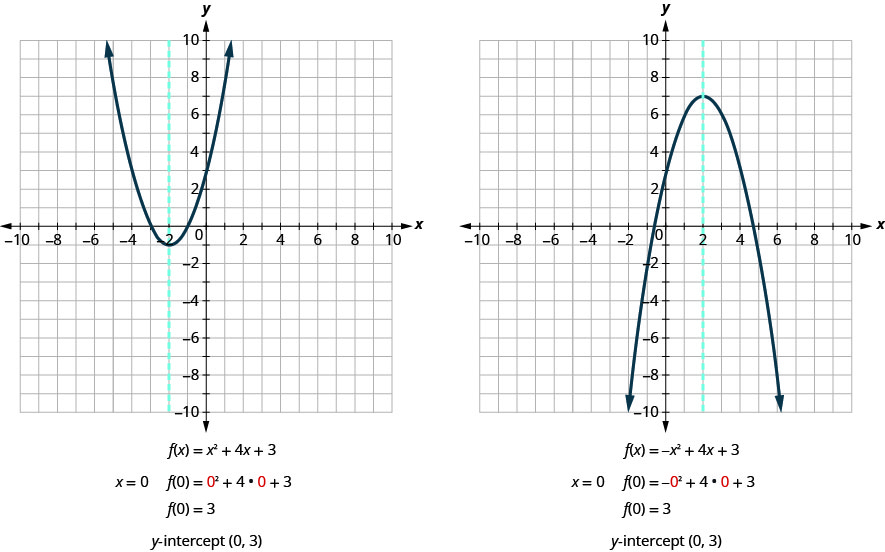
An x-intercept results when the value of f (x) is zero. To find an x-intercept, we let f (x) = 0. In other words, we will need to solve the equation 0 = ax2 + bx + c for x.
Solving quadratic equations like this is exactly what we have done earlier in this chapter!
We can now find the x-intercepts of the two parabolas we looked at. First we will find the x-intercepts of the parabola whose function is f (x) = x2 + 4x + 3.
 |
|
| Let |
 |
| Factor. |  |
| Use the Zero Product Property. |  |
| Solve. |  |
| The x-intercepts are |
Now we will find the x-intercepts of the parabola whose function is f (x) = −x2 + 4x + 3.
 |
|
| Let |
 |
| This quadratic does not factor, so
we use the Quadratic Formula. |
 |
 |
|
| Simplify. |  |
 |
|
 |
|
 |
|
| The x-intercepts are
|
We will use the decimal approximations of the x-intercepts, so that we can locate these points on the graph,
Do these results agree with our graphs? See (Figure).
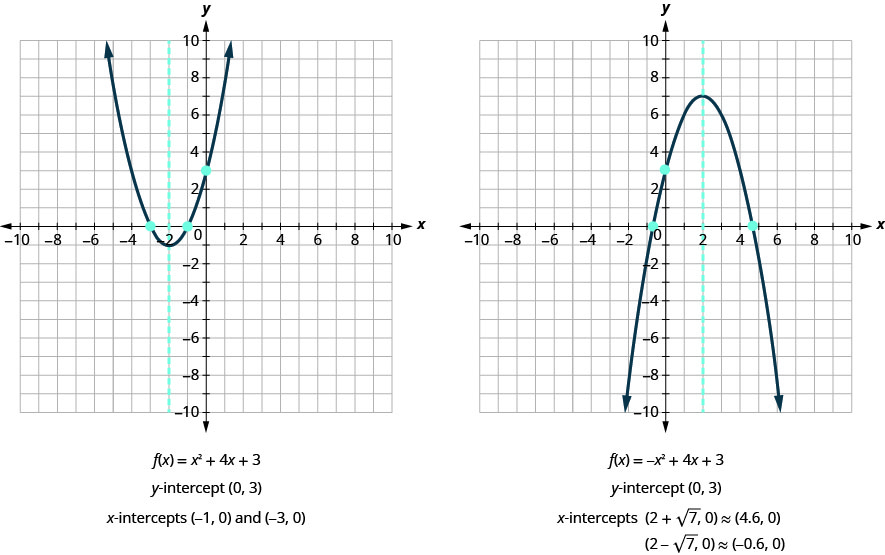
To find the intercepts of a parabola whose function is ![]()
Find the intercepts of the parabola whose function is ![]()
| To find the y–intercept, let solve for |
 |
|
 |
||
 |
||
| When The y–intercept is the point |
||
| To find the x–intercept, let solve for |
 |
|
 |
||
| Solve by factoring. |  |
|
 |
||
 |
||
| When The x–intercepts are the points
|
||
Find the intercepts of the parabola whose function is ![]()
y-intercept: ![]() x-intercepts
x-intercepts ![]()
Find the intercepts of the parabola whose function is ![]()
y-intercept: ![]() x-intercepts
x-intercepts ![]()
In this chapter, we have been solving quadratic equations of the form ax2 + bx + c = 0. We solved for x and the results were the solutions to the equation.
We are now looking at quadratic functions of the form f (x) = ax2 + bx + c. The graphs of these functions are parabolas. The x–intercepts of the parabolas occur where f (x) = 0.
For example:
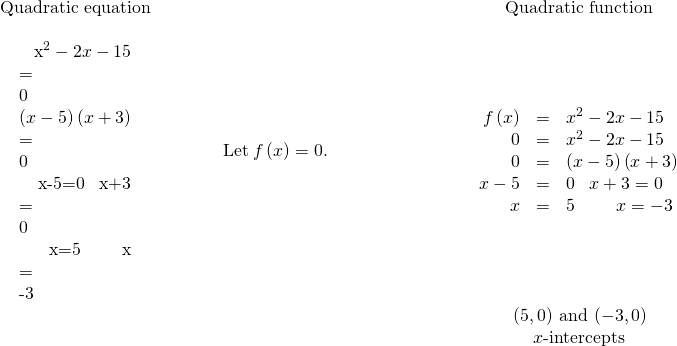
The solutions of the quadratic function are the x values of the x–intercepts.
Earlier, we saw that quadratic equations have 2, 1, or 0 solutions. The graphs below show examples of parabolas for these three cases. Since the solutions of the functions give the x–intercepts of the graphs, the number of x–intercepts is the same as the number of solutions.
Previously, we used the discriminant to determine the number of solutions of a quadratic function of the form ![]() Now we can use the discriminant to tell us how many x-intercepts there are on the graph.
Now we can use the discriminant to tell us how many x-intercepts there are on the graph.
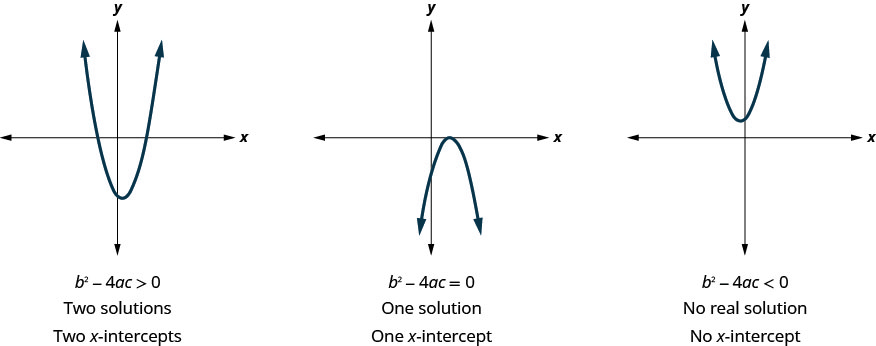
Before you to find the values of the x-intercepts, you may want to evaluate the discriminant so you know how many solutions to expect.
Find the intercepts of the parabola for the function ![]()
 |
|
| To find the y-intercept, let solve for |
 |
 |
|
| When The y-intercept is the point |
|
| To find the x-intercept, let solve for |
 |
 |
|
| Find the value of the discriminant to
predict the number of solutions which is also the number of x-intercepts. |
|
 |
|
| Since the value of the discriminant is
negative, there is no real solution to the equation. There are no x-intercepts. |
Find the intercepts of the parabola whose function is ![]()
y-intercept: ![]() no x-intercept
no x-intercept
Find the intercepts of the parabola whose function is ![]()
y-intercept: ![]() x-intercepts
x-intercepts ![]()
Graph Quadratic Functions Using Properties
Now we have all the pieces we need in order to graph a quadratic function. We just need to put them together. In the next example we will see how to do this.
Graph f (x) = x2 −6x + 8 by using its properties.





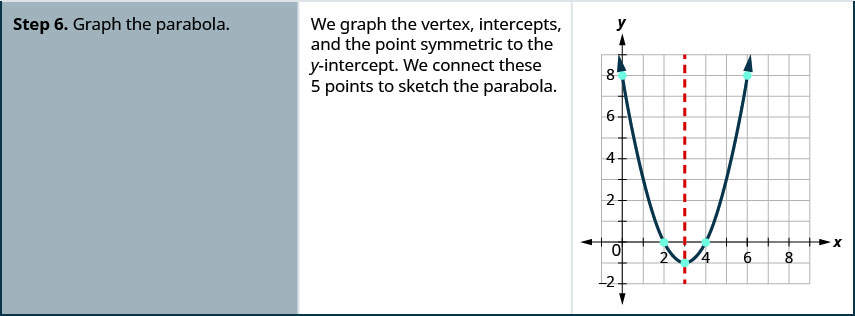
Graph f (x) = x2 + 2x − 8 by using its properties.
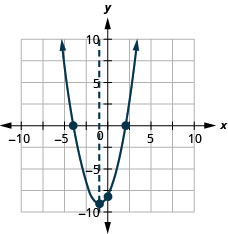
Graph f (x) = x2 − 8x + 12 by using its properties.
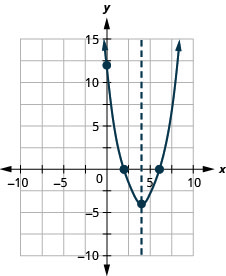
We list the steps to take in order to graph a quadratic function here.
- Determine whether the parabola opens upward or downward.
- Find the equation of the axis of symmetry.
- Find the vertex.
- Find the y-intercept. Find the point symmetric to the y-intercept across the axis of symmetry.
- Find the x-intercepts. Find additional points if needed.
- Graph the parabola.
We were able to find the x-intercepts in the last example by factoring. We find the x-intercepts in the next example by factoring, too.
Graph f (x) = x2 + 6x − 9 by using its properties.
 |
|
| Since a is |
|
 |
|
| To find the equation of the axis of symmetry, use
|
 |
 |
|
 |
|
| The axis of symmetry is The vertex is on the line |
|
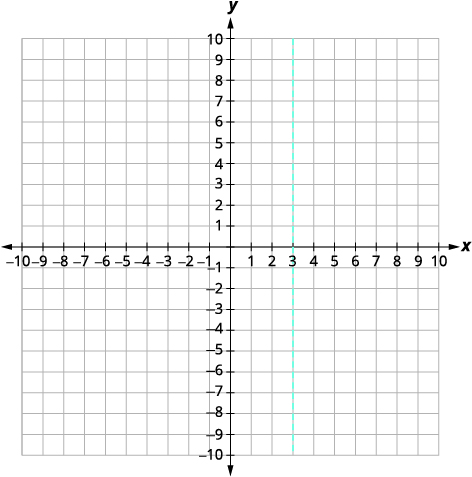 |
|
| Find |
 |
 |
|
 |
|
 |
|
| The vertex is |
|
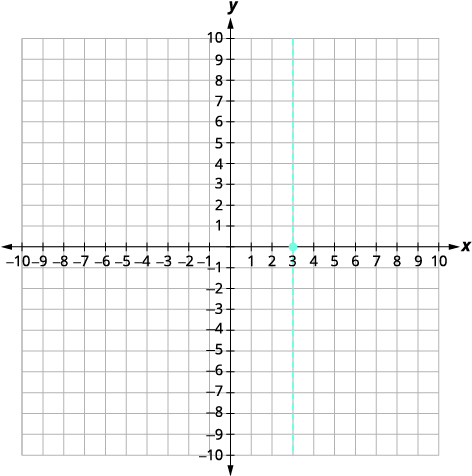 |
|
| The y-intercept occurs when |
 |
| Substitute |
 |
| Simplify. |  |
| The y-intercept is |
|
| The point |
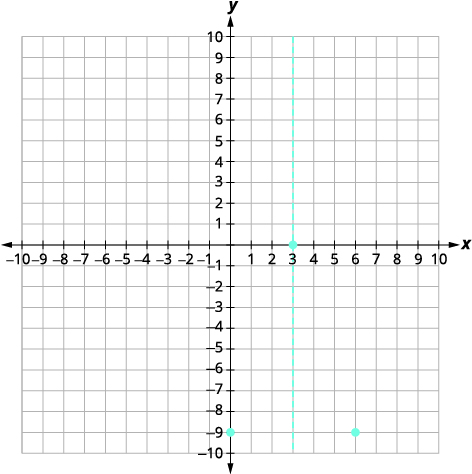 |
| Point symmetric to the y-intercept is |
|
| The x-intercept occurs when |
 |
| Find |
 |
| Factor the GCF. |  |
| Factor the trinomial. |  |
| Solve for x. |  |
| Connect the points to graph the parabola. | 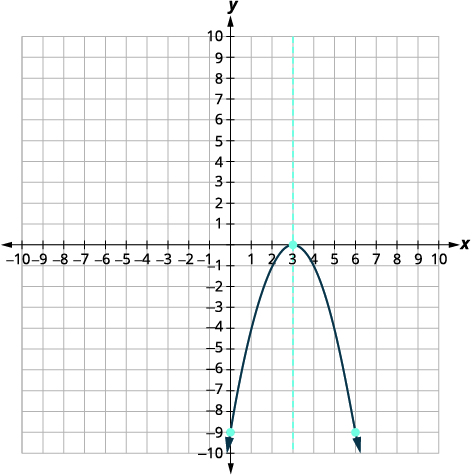 |
Graph f (x) = 3x2 + 12x − 12 by using its properties.
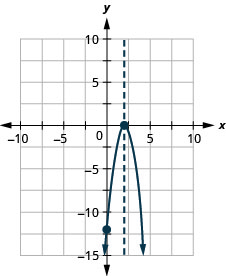
Graph f (x) = 4x2 + 24x + 36 by using its properties.
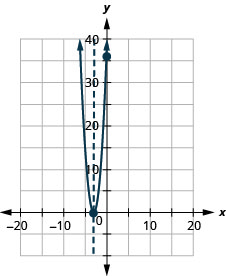
For the graph of f (x) = −x2 + 6x − 9, the vertex and the x-intercept were the same point. Remember how the discriminant determines the number of solutions of a quadratic equation? The discriminant of the equation 0 = −x2 + 6x − 9 is 0, so there is only one solution. That means there is only one x-intercept, and it is the vertex of the parabola.
How many x-intercepts would you expect to see on the graph of f (x) = x2 + 4x + 5?
Graph f (x) = x2 + 4x + 5 by using its properties.
 |
|
| Since a is 1, the parabola opens upward. | |
 |
|
| To find the axis of symmetry, find |
 |
 |
|
 |
|
| The equation of the axis of symmetry is |
|
 |
|
| The vertex is on the line |
|
| Find |
 |
 |
|
 |
|
 |
|
| The vertex is |
|
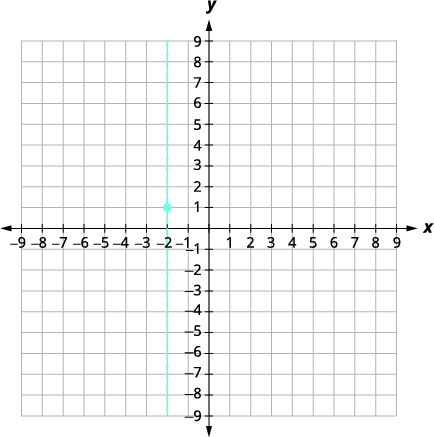 |
|
| The y-intercept occurs when |
 |
| Find |
 |
| Simplify. |  |
| The y-intercept is |
|
| The point symmetry. The point two units to the right of the line of symmetry is |
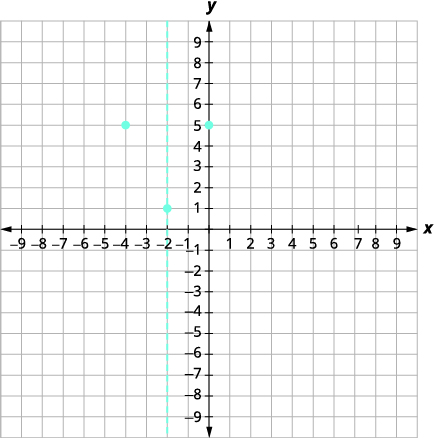 |
| Point symmetric to the y-intercept is |
|
| The x-intercept occurs when |
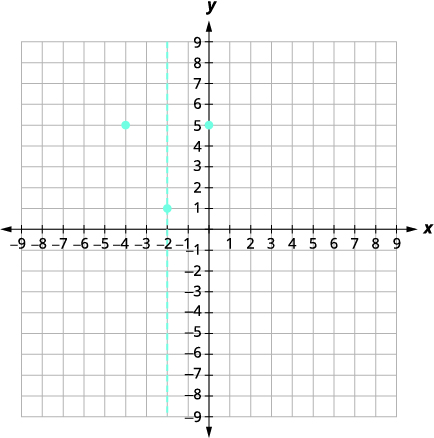 |
| Find |
 |
| Test the discriminant. | |
 |
|
 |
|
 |
|
 |
|
| Since the value of the discriminant is negative, there is
no real solution and so no x-intercept. |
|
| Connect the points to graph the parabola. You may
want to choose two more points for greater accuracy. |
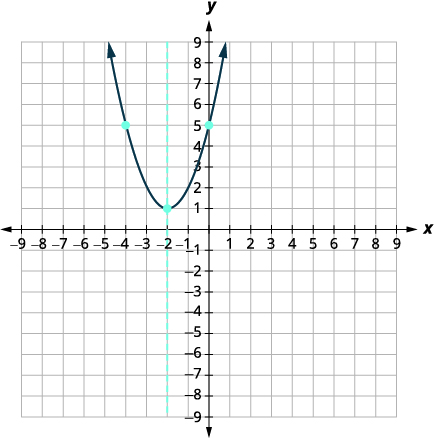 |
Graph f (x) = x2 − 2x + 3 by using its properties.
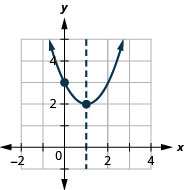
Graph f (x) = −3x2 − 6x − 4 by using its properties.
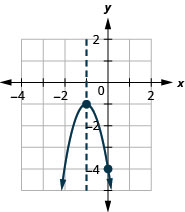
Finding the y-intercept by finding f (0) is easy, isn’t it? Sometimes we need to use the Quadratic Formula to find the x-intercepts.
Graph f (x) = 2x2 − 4x − 3 by using its properties.
 |
|
Since a is 2, the parabola opens upward.  |
|
| To find the equation of the axis of symmetry, use
|
 |
 |
|
 |
|
| The equation of the axis of
symmetry is |
|
| The vertex is on the line |
 |
| Find |
 |
 |
|
 |
|
| The vertex is |
|
| The y-intercept occurs when |
 |
| Find |
 |
| Simplify. |  |
| The y-intercept is |
|
| The point symmetry. |
Point symmetric to the
y-intercept is |
| The point one unit to the right of the line of
symmetry is |
|
| The x-intercept occurs when |
 |
| Find |
 |
| Use the Quadratic Formula. |  |
| Substitute in the values of |
 |
| Simplify. |  |
| Simplify inside the radical. |  |
| Simplify the radical. |  |
| Factor the GCF. |  |
| Remove common factors. |  |
| Write as two equations. |  |
| Approximate the values. |  |
| The approximate values of the
x-intercepts are
|
|
| Graph the parabola using the points found. | 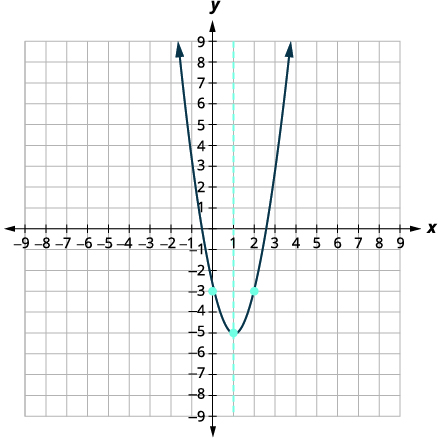 |
Graph f (x) = 5x2 + 10x + 3 by using its properties.
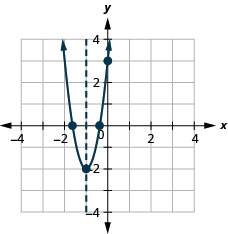
Graph f (x) = −3x2 − 6x + 5 by using its properties.
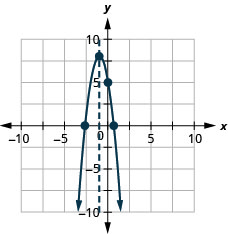
Solve Maximum and Minimum Applications
Knowing that the vertex of a parabola is the lowest or highest point of the parabola gives us an easy way to determine the minimum or maximum value of a quadratic function. The y-coordinate of the vertex is the minimum value of a parabola that opens upward. It is the maximum value of a parabola that opens downward. See (Figure).
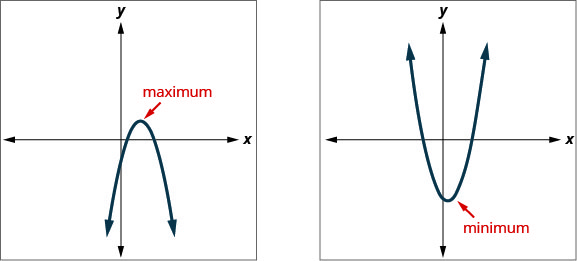
The y-coordinate of the vertex of the graph of a quadratic function is the
- minimum value of the quadratic equation if the parabola opens upward.
- maximum value of the quadratic equation if the parabola opens downward.
Find the minimum or maximum value of the quadratic function ![]()
 |
|
| Since a is positive, the parabola opens upward.
The quadratic equation has a minimum. |
|
| Find the equation of the axis of symmetry. |  |
 |
|
 |
|
| The equation of the axis of
symmetry is |
|
| The vertex is on the line |
 |
| Find |
 |
 |
|
 |
|
| The vertex is |
|
| Since the parabola has a minimum, the y-coordinate of
the vertex is the minimum y-value of the quadratic equation. The minimum value of the quadratic is occurs when |
|
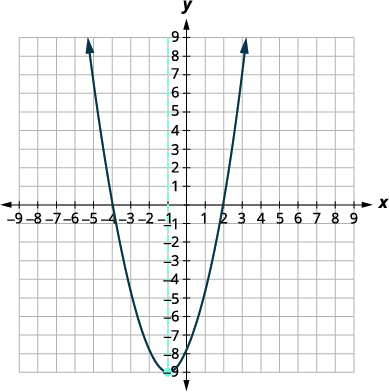 |
|
| Show the graph to verify the result. |
Find the maximum or minimum value of the quadratic function ![]()
The minimum value of the quadratic function is −4 and it occurs when x = 4.
Find the maximum or minimum value of the quadratic function ![]()
The maximum value of the quadratic function is 5 and it occurs when x = 2.
We have used the formula
to calculate the height in feet, h , of an object shot upwards into the air with initial velocity, v0, after t seconds .
This formula is a quadratic function, so its graph is a parabola. By solving for the coordinates of the vertex (t, h), we can find how long it will take the object to reach its maximum height. Then we can calculate the maximum height.
The quadratic equation h(t) = −16t2 + 176t + 4 models the height of a volleyball hit straight upwards with velocity 176 feet per second from a height of 4 feet.
ⓐ How many seconds will it take the volleyball to reach its maximum height? ⓑ Find the maximum height of the volleyball.

ⓐ

ⓑ

Since the parabola has a maximum, the h-coordinate of the vertex is the maximum value of the quadratic function.
The maximum value of the quadratic is 488 feet and it occurs when t = 5.5 seconds.
After 5.5 seconds, the volleyball will reach its maximum height of 488 feet.
Solve, rounding answers to the nearest tenth.
The quadratic function h(t) = −16t2 + 128t + 32 is used to find the height of a stone thrown upward from a height of 32 feet at a rate of 128 ft/sec. How long will it take for the stone to reach its maximum height? What is the maximum height?
It will take 4 seconds for the stone to reach its maximum height of 288 feet.
A path of a toy rocket thrown upward from the ground at a rate of 208 ft/sec is modeled by the quadratic function of h(t) = −16t2 + 208t. When will the rocket reach its maximum height? What will be the maximum height?
It will 6.5 seconds for the rocket to reach its maximum height of 676 feet.
Access these online resources for additional instruction and practice with graphing quadratic functions using properties.
Key Concepts
- Parabola Orientation
- For the graph of the quadratic function
 if
if
- a > 0, the parabola opens upward.
- a < 0, the parabola opens downward.
- For the graph of the quadratic function
- Axis of Symmetry and Vertex of a Parabola The graph of the function
 is a parabola where:
is a parabola where:
- the axis of symmetry is the vertical line

- the vertex is a point on the axis of symmetry, so its x-coordinate is

- the y-coordinate of the vertex is found by substituting
 into the quadratic equation.
into the quadratic equation.
- the axis of symmetry is the vertical line
- Find the Intercepts of a Parabola
- To find the intercepts of a parabola whose function is


- To find the intercepts of a parabola whose function is
- How to graph a quadratic function using properties.
- Determine whether the parabola opens upward or downward.
- Find the equation of the axis of symmetry.
- Find the vertex.
- Find the y-intercept. Find the point symmetric to the y-intercept across the axis of symmetry.
- Find the x-intercepts. Find additional points if needed.
- Graph the parabola.
- Minimum or Maximum Values of a Quadratic Equation
- The y-coordinate of the vertex of the graph of a quadratic equation is the
- minimum value of the quadratic equation if the parabola opens upward.
- maximum value of the quadratic equation if the parabola opens downward.
Practice Makes Perfect
Recognize the Graph of a Quadratic Function
In the following exercises, graph the functions by plotting points.
![]()
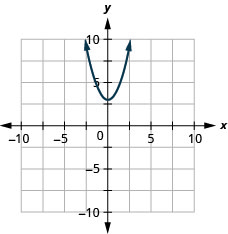
![]()
![]()
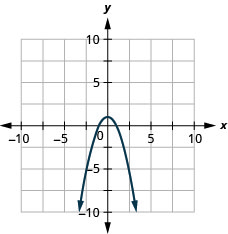
![]()
For each of the following exercises, determine if the parabola opens up or down.
ⓐ![]()
ⓑ![]()
ⓐ down ⓑ up
ⓐ![]()
ⓑ![]()
ⓐ![]()
ⓑ![]()
ⓐ down ⓑ up
ⓐ![]()
ⓑ![]()
Find the Axis of Symmetry and Vertex of a Parabola
In the following functions, find ⓐ the equation of the axis of symmetry and ⓑ the vertex of its graph.
![]()
ⓐ![]() ; ⓑ
; ⓑ![]()
![]()
![]()
ⓐ![]() ; ⓑ
; ⓑ![]()
![]()
Find the Intercepts of a Parabola
In the following exercises, find the intercepts of the parabola whose function is given.
![]()
y-intercept: ![]() x-intercept
x-intercept ![]()
![]()
![]()
y-intercept: ![]() x-intercept
x-intercept ![]()
![]()
![]()
y-intercept: ![]() x-intercept: none
x-intercept: none
![]()
![]()
y-intercept: ![]() x-intercept: none
x-intercept: none
![]()
![]()
y-intercept: ![]() x-intercept
x-intercept ![]()
![]()
![]()
y-intercept: ![]() x-intercept
x-intercept ![]()
![]()
Graph Quadratic Functions Using Properties
In the following exercises, graph the function by using its properties.
![]()
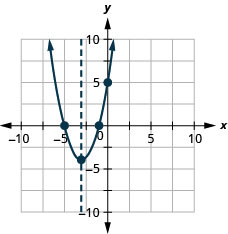
![]()
![]()
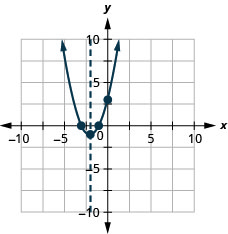
![]()
![]()
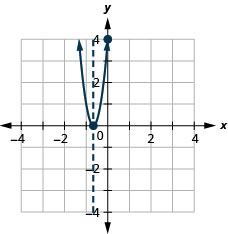
![]()
![]()
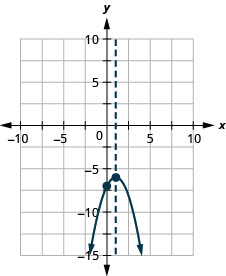
![]()
![]()
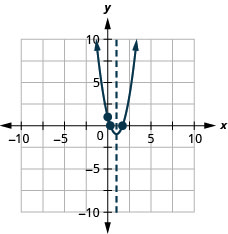
![]()
![]()
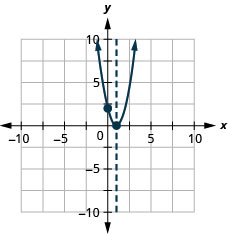
![]()
![]()
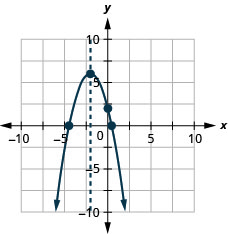
![]()
![]()
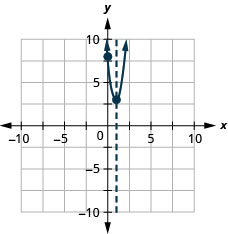
![]()
![]()

![]()
Solve Maximum and Minimum Applications
In the following exercises, find the maximum or minimum value of each function.
![]()
The minimum value is ![]() when
when ![]()
![]()
![]()
The maximum value is 6 when x = 3.
![]()
![]()
The maximum value is 16 when x = 0.
![]()
In the following exercises, solve. Round answers to the nearest tenth.
An arrow is shot vertically upward from a platform 45 feet high at a rate of 168 ft/sec. Use the quadratic function h(t) = −16t2 + 168t + 45 find how long it will take the arrow to reach its maximum height, and then find the maximum height.
In 5.3 sec the arrow will reach maximum height of 486 ft.
A stone is thrown vertically upward from a platform that is 20 feet height at a rate of 160 ft/sec. Use the quadratic function h(t) = −16t2 + 160t + 20 to find how long it will take the stone to reach its maximum height, and then find the maximum height.
A ball is thrown vertically upward from the ground with an initial velocity of 109 ft/sec. Use the quadratic function h(t) = −16t2 + 109t + 0 to find how long it will take for the ball to reach its maximum height, and then find the maximum height.
In 3.4 seconds the ball will reach its maximum height of 185.6 feet.
A ball is thrown vertically upward from the ground with an initial velocity of 122 ft/sec. Use the quadratic function h(t) = −16t2 + 122t + 0 to find how long it will take for the ball to reach its maximum height, and then find the maximum height.
A computer store owner estimates that by charging x dollars each for a certain computer, he can sell 40 − x computers each week. The quadratic function R(x) = −x2 +40x is used to find the revenue, R, received when the selling price of a computer is x, Find the selling price that will give him the maximum revenue, and then find the amount of the maximum revenue.
20 computers will give the maximum of ?400 in receipts.
A retailer who sells backpacks estimates that by selling them for x dollars each, he will be able to sell 100 − x backpacks a month. The quadratic function R(x) = −x2 +100x is used to find the R, received when the selling price of a backpack is x. Find the selling price that will give him the maximum revenue, and then find the amount of the maximum revenue.
A retailer who sells fashion boots estimates that by selling them for x dollars each, he will be able to sell 70 − x boots a week. Use the quadratic function R(x) = −x2 +70x to find the revenue received when the average selling price of a pair of fashion boots is x. Find the selling price that will give him the maximum revenue, and then find the amount of the maximum revenue per day.
He will be able to sell 35 pairs of boots at the maximum revenue of ?1,225.
A cell phone company estimates that by charging x dollars each for a certain cell phone, they can sell 8 − x cell phones per day. Use the quadratic function R(x) = −x2 +8x to find the revenue received per day when the selling price of a cell phone is x. Find the selling price that will give them the maximum revenue per day, and then find the amount of the maximum revenue.
A rancher is going to fence three sides of a corral next to a river. He needs to maximize the corral area using 240 feet of fencing. The quadratic equation A(x) = x(240 − 2x) gives the area of the corral, A, for the length, x, of the corral along the river. Find the length of the corral along the river that will give the maximum area, and then find the maximum area of the corral.
The length of the side along the river of the corral is 120 feet and the maximum area is 7,200 square feet.
A veterinarian is enclosing a rectangular outdoor running area against his building for the dogs he cares for. He needs to maximize the area using 100 feet of fencing. The quadratic function A(x) = x(100 − 2x) gives the area, A, of the dog run for the length, x, of the building that will border the dog run. Find the length of the building that should border the dog run to give the maximum area, and then find the maximum area of the dog run.
A land owner is planning to build a fenced in rectangular patio behind his garage, using his garage as one of the “walls.” He wants to maximize the area using 80 feet of fencing. The quadratic function A(x) = x(80 − 2x) gives the area of the patio, where x is the width of one side. Find the maximum area of the patio.
The maximum area of the patio is 800 feet.
A family of three young children just moved into a house with a yard that is not fenced in. The previous owner gave them 300 feet of fencing to use to enclose part of their backyard. Use the quadratic function A(x) = x(300 − 2x) to determine the maximum area of the fenced in yard.
Writing Exercise
How do the graphs of the functions ![]() and
and ![]() differ? We graphed them at the start of this section. What is the difference between their graphs? How are their graphs the same?
differ? We graphed them at the start of this section. What is the difference between their graphs? How are their graphs the same?
Answers will vary.
Explain the process of finding the vertex of a parabola.
Explain how to find the intercepts of a parabola.
Answers will vary.
How can you use the discriminant when you are graphing a quadratic function?
Self Check
ⓐ After completing the exercises, use this checklist to evaluate your mastery of the objectives of this section.

ⓑ After looking at the checklist, do you think you are well-prepared for the next section? Why or why not?
Glossary
- quadratic function
- A quadratic function, where a, b, and c are real numbers and
 is a function of the form
is a function of the form 

